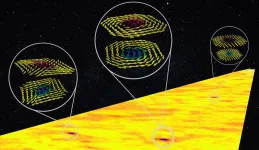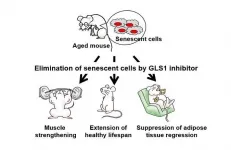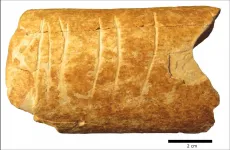NUI Galway demonstrate the promise of precision genomics in cancer treatment
NUI Galway scientists find signatures of long-term survival in the genomes of the most common type of breast cancer
2021-02-04
(Press-News.org) Researchers at NUI Galway have identified genomic signatures in women developing the most common type of breast cancer that can be associated with long-term survival. The NUI Galway team analysed the genomes of breast cancer patients to look for associations with survival rates using advanced statistical techniques.
Carried out by Lydia King during her studies in NUI Galway's MSc in Biomedical Genomics programme, the research has been published in the international journal PLOS ONE.
Early detection by national screening programmes and timely treatment for patients diagnosed with "luminal" types of breast cancer have resulted in excellent prognoses with survival rates of over 80% within five years of treatment. The challenge of long-term survival however is not as well understood and studies have shown that more than half of all recurrences for luminal breast cancers takes place after this time point. Identifying patients most likely to suffer relapses would therefore be invaluable to patient monitoring and choice of therapies.
Genomes are the collection of all DNA in the chromosomes of cells containing all of our inherited genetic information. Cancer is often described as a disease of the genome because it is a consequence of alterations in the instructions encoded within some of our cell's DNA that lead to them proliferating without restraint. These alterations are a hallmark of a tumour and can range from single base-pair errors in the DNA code to the duplication or deletion of entire chromosome arms. The level of alterations in the genome of a cancer cell is known as 'genome instability'.
The NUI Galway team focused on whether an overall measurement of genome instability in cancer cells from luminal breast cancer patients, observed at diagnosis and before treatment started, could provide additional information in predicting their long-term survival. To test this hypothesis, they analysed data from the Molecular Taxonomy of Breast Cancer International Consortium (METABRIC) led by Cambridge University.
METABRIC is one of the first multi-centre studies aimed at uncovering links between the clinical and genomic properties of biopsies taken from over 2000 patients suffering from primary breast carcinoma enrolled between 1977 and 2005. The richness of having both high quality genomic data and the up-to-date clinical data makes the METABRIC database a very powerful resource for researching breast cancer.
Lydia and her colleagues calculated the level of genome instability across all 2,000 patient genomes, then used multivariable statistical modelling to identify distinct long term survival outcomes for luminal subtype breast cancer patients. This enabled them to confirm the significantly worse prognoses for luminal A patients suffering from the most extreme levels of genome instability in their tumour biopsies.
Importantly, the NUI Galway researchers were able to stratify the patients into groups and link the genome instability score with clinical classifications. This provided clear evidence that patients diagnosed with Luminal A breast cancer that had high levels of genome instability exhibited similar patterns of reduced survival commonly seen in patients suffering from the more aggressive Luminal B subtype. Since patients identified as either Luminal A or B subtypes normally receive different treatments, the result suggests that incorporating genomic analysis into clinical care could improve diagnosis and allow oncologists to tailor treatments for individual patients. This approach of using genomic analysis is known as "precision (or genomic) medicine" and is helping to define a new standard of care in many areas of clinical practice.
Senior author of the paper, Dr Aaron Golden of NUI Galway's School of Mathematics, Statistics and Applied Mathematics, said: "This is an excellent example of how interdisciplinary research is supposed to work in the genomics data sciences. This started out as a speculative idea between myself, a physicist, and my colleague Dr Andrew Flaus, who is a biochemist from the School of Natural Sciences, and was taken by Lydia for her MSc dissertation project. We then received the invaluable assistance of our statistician colleague Dr Emma Holian and through Lydia's phenomenally hard work we could demonstrate the promise of precision genomics in cancer treatment."
Commenting on this result, Dr Pilib Ó Broin, Programme Director of NUI Galway's MSc in Biomedical Genomics, added: "This is a fantastic result for Lydia and her supervisors and highlights the enormous benefits of training interdisciplinary scientists like Lydia who possess both the statistical and computational skills as well as the domain knowledge necessary to generate new biological insights from genomics data with the potential to improve patient care."
INFORMATION:
Lydia has since graduated with her Masters and has taken up a place as a PhD student in the Science Foundation Ireland funded Centre for Research Training in Genomics Data Science led by NUI Galway where she is continuing her work on the analysis of cancer genomes.
The PLOS ONE manuscript titled 'Survival outcomes are associated with genomic instability in luminal breast cancers' can be read at: https://journals.plos.org/plosone/article?id=10.1371/journal.pone.0245042
-Ends-
ELSE PRESS RELEASES FROM THIS DATE:
2021-02-04
FOOD SCIENCE Sweden takes first, Denmark second and Norway lags at the bottom when it comes to how much organic food is served in canteens, kindergartens and other public sector workplaces across the three Nordic nations. This, according to the results of a new report by the University of Copenhagen. The report details plenty of potential for expanding the conversion to organic food service in the Danish public sector--a topic of discussion across the EU at the moment.
Plate with potatoes and beef
The governments of Denmark, Norway and Sweden are all keen on ramping up the amount of organic food ...
2021-02-04
The FinnBrain research of the University of Turku has demonstrated for the first time that the stress the father has experienced in his childhood is connected to the development of the white matter tracts in the child's brain. Whether this connection is transmitted through epigenetic inheritance needs further research.
Evidence from multiple new animal studies demonstrates that the changes in gene function caused by environment can be inherited between generations through gametes. In particular, nutrition and stress have been proven to cause these types of changes. However, these do not alter the nucleic acid sequence of ...
2021-02-04
Today's digital world generates vast amounts of data every second. Hence, there is a need for memory chips that can store more data in less space, as well as the ability to read and write that data faster while using less energy.
Researchers from the National University of Singapore (NUS), working with collaborators from the University of Oxford, Diamond Light Source (the United Kingdom's national synchrotron science facility) and University of Wisconsin Madison, have now developed an ultra-thin material with unique properties that could eventually achieve some of these goals. Their ...
2021-02-04
A study published in the journal Pediatrics expands validation evidence for a new screening tool that directly engages preschool-age children during clinic visits to assess their early literacy skills. The tool, which is the first of its kind, has the potential to identify reading difficulties as early as possible, target interventions and empower families to help their child at home, according to researchers at Cincinnati Children's Hospital Medical Center.
The Reading House (TRH) is an assessment for ages 3-5 based on a specially designed children's book, which was developed by John Hutton, MD, and his team at Cincinnati Children's. Screening takes five minutes and gauges performance levels ...
2021-02-04
An inexpensive, long-lasting and easy-to-administer vaccine against malaria could be a game-changer for millions of people living in countries where the mosquito-borne disease is endemic.
Lucie Jelinkova, a graduate student in the laboratory of Bryce Chackerian, PhD, professor in The University of New Mexico Department of Molecular Genetics & Microbiology, has identified a method that could make that dream into reality.
In research recently published in the journal NPJ Vaccines, Jelinkova and colleagues at Johns Hopkins and Flinders University in Australia report ...
2021-02-04
Tuberous sclerosis complex (TSC) afflicts as many as two million people around the world, affecting multiple organs, including lungs, brain, skin and kidneys. In about 80 percent of cases, it causes cysts and benign tumors to form in the kidney, eventually resulting in kidney failure.
It's known that the disease is triggered by genetic mutations, but how these mutations lead to the formation of kidney cysts has been poorly understood - until now.
Nephrologist Manoocher Soleimani, MD, a professor in The University of New Mexico Department of Internal Medicine, led a team that solved the puzzle and pointed the way toward potential ...
2021-02-04
Twitter has long provided a short, sharp take on the community's fears, anxieties and experiences. Now, data scientists have analysed 94 million tweets from the first months of the pandemic to track COVID-19's effect on mental health in NSW.
The research team used machine learning to develop a model able to capture data indicating depression, stress, anxiety and suicidal thoughts among users of the social media platform.
The aim was to tap into popular technology to help public health experts identify changes in community levels of depression over time.
The World Health Organisation highlighted early in 2020 that the pandemic would likely have a negative impact on mental health, with the disease affecting many facets of life including work, health and relationships.
Researchers from ...
2021-02-04
Senescent cells accumulate in organs during aging, promote tissue dysfunction, and cause numerous aging-related diseases like cancer. The cells arise through a process called "cellular senescence," a permanent cell cycle arrest resulting from multiple stresses.
A collaborative research group led by Professor Makoto Nakanishi of the Institute of Medical Science, The University of Tokyo (IMSUT), and co-researchers has identified an inhibitor of the glutamate metabolic enzyme GLS1(*1) so that its administration selectively eliminates senescent cells in vivo. They confirmed that the GLS1 inhibitor eliminated senescent cells from various organs and tissues in aged mice, ameliorating age-associated tissue dysfunction and the symptoms of obese diabetes, arteriosclerosis, and ...
2021-02-04
While scientists and historians have long surmised that etchings on stones and bones have been used as a form of symbolism dating back as early as the Middle Paleolithic period (250,000-45,000 BCE), findings to support that theory are extremely rare.
A recent discovery by archeologists from the Hebrew University and the University of Haifa alongside a team from the Le Centre National de la Recherche Scientifique in France have uncovered evidence of what may be the earliest-known use of symbols. The symbols were found on a bone fragment in the Ramle region in central ...
2021-02-04
A City of Hope-led research team found that the same gene that increases the risk for Alzheimer's disease, ApoE4, can increase the susceptibility to and severity of COVID-19.
"Our study provides a causal link between the Alzheimer's disease risk factor ApoE4 and COVID-19 and explains why some (e.g., ApoE4 carriers) but not all COVID-19 patients exhibit neurological manifestations" said Yanhong Shi, Ph.D., director of the Division of Stem Cell Biology at City of Hope and co-corresponding author of the new study. "Understanding how risk factors for neurodegenerative diseases ...
LAST 30 PRESS RELEASES:
[Press-News.org] NUI Galway demonstrate the promise of precision genomics in cancer treatment
NUI Galway scientists find signatures of long-term survival in the genomes of the most common type of breast cancer




